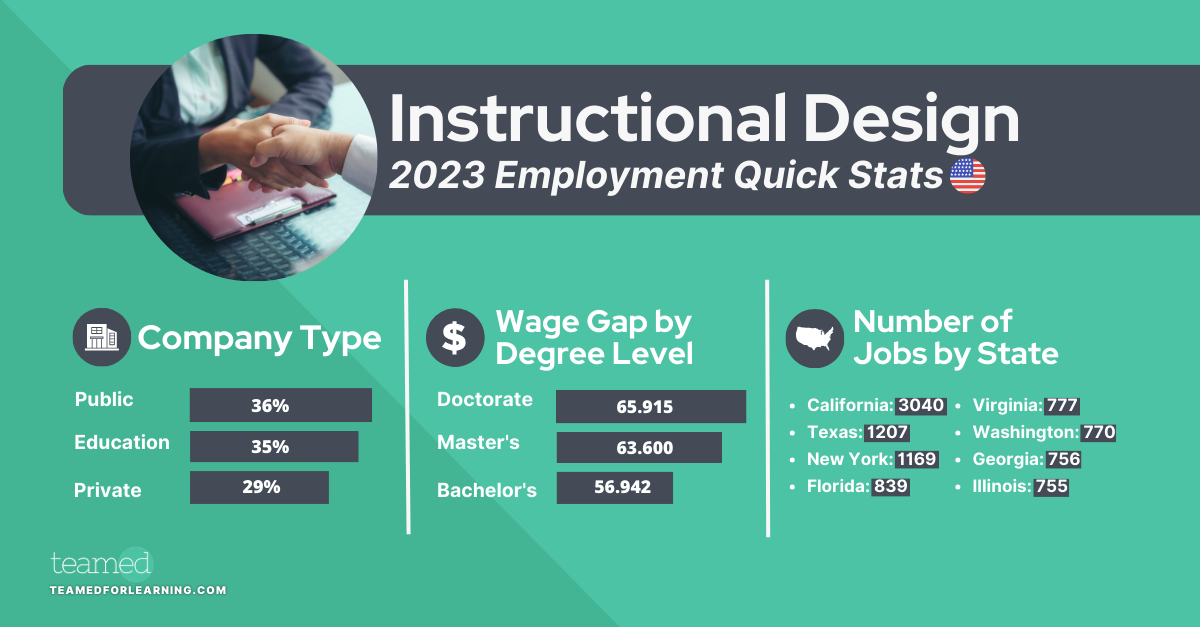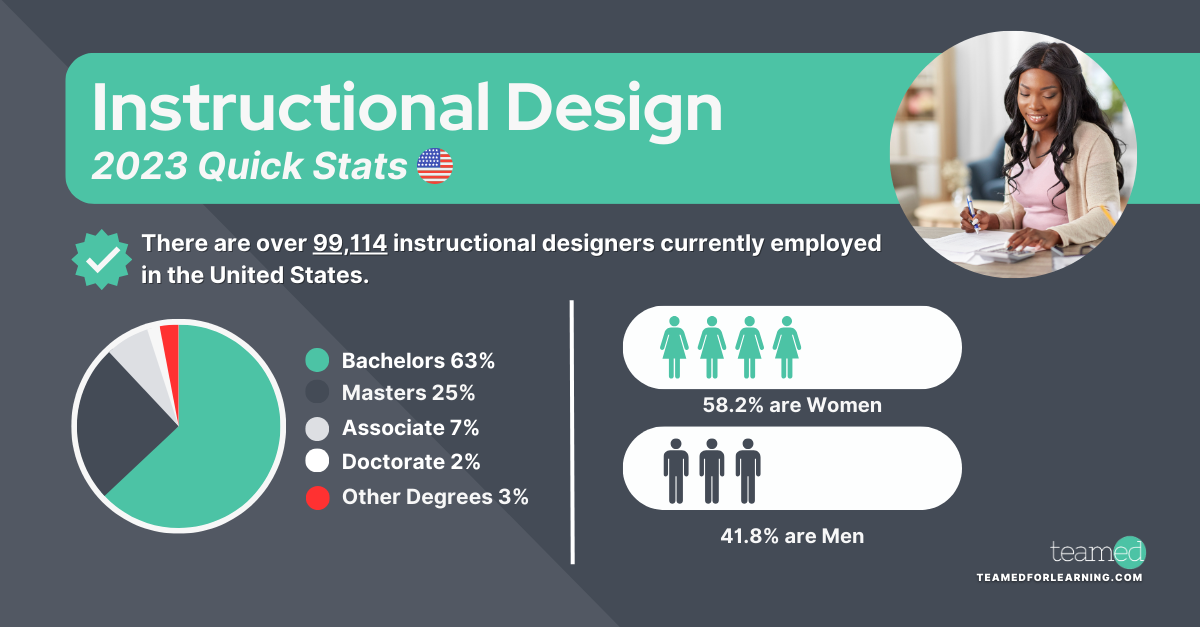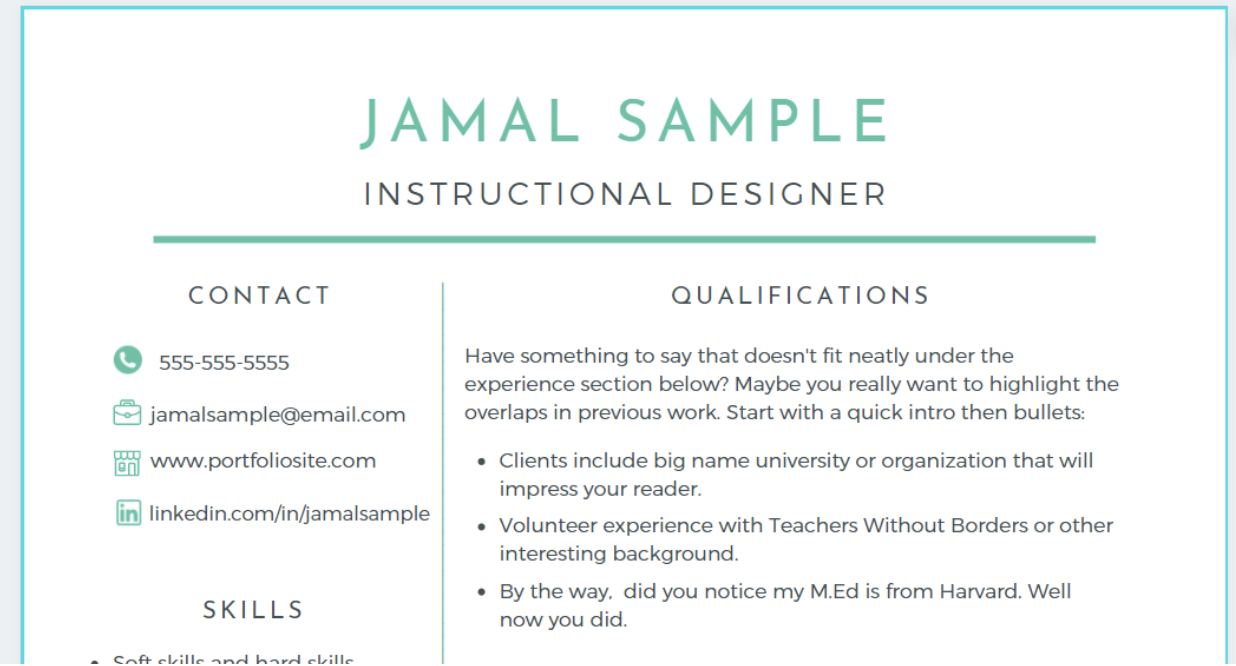Instructional Design: The Complete Guide

Instructional designers are the superheroes of the elearning world. They bring a unique mix of skills and experience to organizations that teach or train. Under their expert guidance, information and ideas transform into useful elearning products. As digital learning has risen in popularity, so has the demand for instructional design professionals.
Being a great instructional designer takes training, experience, and a learner-first approach. Having the right instructional designer on your team can make the whole design and development process easier.
Whether you want to become an instructional designer or hire one, here’s everything you need to know about this rapidly evolving role.
What is Instructional Design?
Instructional design is the practice of designing and developing instructional materials by analyzing and systematically addressing learning needs. The instructional design process can be used to design and develop:
- Online courses
- Learning simulations
- Employee training modules
- Digital learning products
The people who do this vital work are called instructional designers (ID), although they may have other titles like learning experience designer, instructional systems designer, or instructional technologist.
Whatever you call them, they apply learning theory and technical expertise to create instructional materials.
What does an Instructional Designer do?
Instructional designers support and oversee the development of courses or learning materials. Most often, they work as a member of a course design and development team.
Their exact responsibilities may fluctuate depending on the size of the team and the project. However, IDs are often responsible for:
- Assessing the audience and the need
- Collaborating with subject matter experts and other stakeholders
- Defining learning outcomes and developing a learning strategy
- Aligning content, activities, and assessments with desired outcomes
- Curating and developing content
- Creating interactive learning modules
- Building and setting up online courses
- Project management and strategic communication
- Assessing performance and iterating
Throughout the course development process, instructional designers ensure that the team follows best practices and the latest learning theory. As experts in elearning, they address the unique challenges and opportunities presented by digital, hybrid, and in-person instruction.
Whether creating new learning experiences from scratch, refreshing content, or converting an in-person course for online learners, IDs ensure every learning experience meets learner needs.
The Instructional Design Market
Instructional design doesn’t fit neatly into one industry. Organizations across a range of industries need instructional designers. Each industry has unique challenges and opportunities. You’ll find a range of salaries and career pathways across industries, but one thing unites them all. The recent shift toward online and hybrid learning means that instructional design is an in-demand role in almost any industry.
Organizations in all Types of Industries Hire Instructional Designers
Instructional designers can work in pretty much any industry. From corporate learning to K-12, any organization that is focused on developing specific knowledge, skills, or behaviors needs an instructional designer.
That includes organizations that you might not think of as focused on learning, like sports teams, nonprofits, and professional associations. If an organization is responsible for training, development or education in any capacity, it will probably work with an instructional designer to develop those resources.
Sectors that hire Instructional Designers Include:
- Corporate – Instructional designers support the learning and development function and are often focused on onboarding, career pathway curriculum, upskilling, compliance training, and more.
- Government – Similar to corporate organizations, any government agency that creates training for employees or the public needs instructional designers.
- Non-Profit – In the nonprofit sector, instructional designers help create training for employees, volunteers and sometimes the public.
- Higher Education – Instructional designers transform in-person college courses into online offerings or create new courses from scratch.
- K-12 – The shift toward remote learning has expanded instructional design opportunities to include elementary, middle, and secondary schools.
- Edtech and Publishing – The instructional designer plays a key role in developing eLearning products that are sold to organizations or directly to customers.
Instructional designers in each of these sectors need a slightly different combination of skills and experience. While many of the job duties overlap, the difference in goals and audience can have a major impact on the role. Salary ranges also vary depending on the industry.
Instructional Designers salary
Instructional design salaries vary depending on speciality, industry, and employment classification. ID’s may choose to work full-time, part-time, or as freelance or contract workers.
Across all employment classifications, the highest salaries go to IDs working in corporate organizations. Salaries are usually lowest in higher education and K-12.
In the United States, full-time instructional designers make about $78,094 per year on average. Senior instructional designers may make an additional $10,000 per year. As with many jobs, these salaries can fluctuate based on location, years of experience, and level of responsibility.
What are the career pathways for instructional designers?
There is a lot of opportunity for growth in instructional design. Because of the wide range of industries and organizations that hire instructional designers, these professionals can easily seek out new challenges to grow their skills.
Some instructional designers may also choose to specialize. In fact, choosing a specialty in instructional design can help IDs differentiate themselves in the job market. Common specialities include:
- Learning design and strategy
- Content and script writing
- Instructional technology and LMS administration
- eLearning development
- Graphic and UI/UX Design
- Project and/or product management
Instructional designers may also put their skills to work by training instructors on how to best design curriculums for digital learning and teach online courses. Some instructional designers choose to transition into a management role, where they coordinate the entire instructional design process.
The speciality an industry an instructional designer works in will impact how much they can make as an ID.
How To Become an Instructional Designer
There’s not a single path to becoming an instructional designer. Many professionals discover this field when engaged in HR, training, multimedia development, or content creation roles.
Teachers also, rightly, identify this field as an alternative career pathway with more diverse opportunity and advancement.
Lastly, new graduates are entering the field from colleges with specialized degrees in instructional design and technology. Here’s what you need to know to get started.
What credentials or experience do I need to be an instructional designer?
The path into instructional design varies from person to person. This also means organizations hire individuals with various backgrounds and credentials.
The hiring manager is looking for key knowledge, skills, and behaviors. If you are new to the profession, you will need to demonstrate at least one of the following, but if you can meet all three you’ll be an especially strong candidate.
Relevant Degree or Credential
Most organizations first check to see if you have an education credential related to instructional design. The best credential is a Master’s degree in instructional design and technology.
But, a graduate certificate or even upskilling courses are also often recognized and accepted, particularly when the other key areas below are met.
Tip: If you already have a Master’s degree in another field and relevant experience or a great portfolio – you don’t need to complete a full master’s program to be successful in pivoting to instructional design. Consider acquiring the basic knowledge credential foundations to make faster progress in transitioning.
Instructional Design Portfolio
Most employers will ask to see samples of your work. While many instructional designers create portfolio websites, a simple Google Drive folder works just as well.
Depending on your area of focus and the types of ID jobs you are applying for, consider including a design document, elearning module, storyboard or other end products and assets.
You can stand out to a hiring manager by adding a link to samples on your resume. Here are portfolio development tips.
Relevant Experience
We know…it’s hard to get experience when you don’t have experience. Consider a volunteer project at a local organization, an online internship, contract jobs, or perhaps there’s an opportunity to create a learning solution with your current employer.
Hiring managers love to see people who take initiative and have early experience.
What are instructional design degree programs and sources for upskilling?
Like any skilled role, instructional design requires a blend of education and skills. While there’s no single path to becoming an instructional designer, credentials can help enhance your candidacy.
The instructional design degree program or upskilling credential you choose depends on your level of experience, existing degrees, and goals.
Degree Programs for Instructional Designers
Bloomsburg University, MS Instructional Design and Technology
Bloomsburg University offers a strong program including hands-on, guided experience with a focus on learning technology.
In addition, they have a corporate and education track that can help you learn the industry relevant skills and language. Their graduates have a record of being well equipped when entering the workforce.
University of Wisconsin – Stout, Graduate Certificate in Instructional Design
This is a fantastic option for those who already possess a Master’s degree and are seeking to transition careers quickly and develop a strong foundation of knowledge and skills.
Non-Degree Training and Upskilling
IDOL Courses Academy – An authorized trade school offering a certificate in instructional design
Teacher Transition – A course to help transitioning teachers become curriculum and instructional designers
Mastering Instructional Design – Live and on-demand classes as well as workshops from an experienced instructional designer
Instructional Design Principles for Course Creation – A bootcamp from Eduflow Academy that teaches online course design
Instructional Design Institute with Luke Hobson – A community offering professional development for instructional designers
What are the top instructional designer skills?
All instructional designers need an understanding of instructional design processes, best practices, and learning theory. They are responsible for identifying the need, designing a solution, and keeping the learner at the center of all design decisions.
In addition to these core skills, instructional design job seekers can stand out with skills like:
- Learning design strategy
- Agile development practices
- Project management
- Video production
- Graphic design
- Marketing
- Game design/gamification
- Accessible design
- Quality assurance
- LMS administration
The value of each of these skills depends on the industry you’re working in. A successful instructional design resume is tailored to the industry and the role.
Business acumen is a rising,in-demand skill across many industries. More organizations are recognizing that a training curriculum is a product.
Being able to align learning design strategy with business needs can make you a more competitive instructional design candidate across industries.
How to find instructional design jobs
Since organizations of all types need instructional designers, you can find instructional design jobs on many general job boards. However, general job boards can be time consuming because you have to sift through a lot of irrelevant jobs and search functions don’t always work as well as you would hope.
Specialized job boards like the Teamed Job Board can save you time when searching for instructional design jobs. Getting help from a talent placement specialist can also help you find jobs that might not even be listed yet.
That old statistic about 70% jobs being filled without ever being listed is almost certainly an exaggeration, but it’s true that many jobs really are through networks and word of mouth.
A talent placement specialist can make sure you’re not missing out on opportunities.
How do I get my first instructional designer job?
There are three main ways to find your first instructional designer jobs. While other routes are possible. These three are the most common.
- Internships
- Temporary or contract roles
- Entry-level employment
Internships for instructional designers
Many instructional designers land their first role through internships. Most internships are only available if you’re studying instructional design or a related field in college. However, it is sometimes possible to find an internship when you’re not in school.
If you go the internship route, look for one that will provide you with real, hands-on experience, not just school credit. At the same time, don’t be surprised if your contributions are limited or the oversight on you is heavy at first.
This can be a challenging adjustment for people who have held other professional roles and are used to more autonomy.
Temporary and Contract Roles for Instructional Designers
You might find that a temporary or contract role might be a better way to find your first instructional designer job. Temporary and contract positions offer an opportunity to put real experience on your resume, and can help you prove your skills to hiring managers.
In some cases, temporary roles can turn into full-time employment. They’re also open to people who aren’t in college and may not qualify for a standard internship.
Entry-level roles for instructional designers
In some cases, you may be able to find entry level roles in learning design or learning development that will allow you to work under a more experienced instructional designer.
If you deliver high quality work, there may be room to grow and expand your duties.
Just keep in mind that not all organizations work this way. If your plan is to start off at the entry level and work your way up in an organization, ask questions during the interview process to understand whether this type of internal mobility is built into the role.
Where can I find instructional designer internships?
The first place to look for instructional designer internships is your college’s career office. Professionals there should be able to help match you to an internship or connect you with a talent specialist who can.
You can also check out job boards like the Teamed Job Board or other relevant websites to find organizations seeking interns.
Key Job Search Documents For Instructional Designers
Three key job search documents can help instructional designers find their next role. Before you start looking for an instructional design job, make sure you have a:
- Resume
- LinkedIn profile
- Portfolio
Each of these job search documents should be tailored to the industry you hope to work in. Keep in mind that many industries hire instructional designers, and each one has their own jargon.
Make sure your instructional design job search document uses the preferred language of the industry you hope to work in.
Take care to only use keywords that you fully understand. Some of the words that differ across industries aren’t direct synonyms. Using the specific language of an industry implies that you really understand what that word means in context.
So make sure you really do!
Instructional design resume
The ideal instructional design resume includes the right skills and keywords for the industry.
When writing your instructional design resume, follow resume writing best practices. Avoid gimmicky formats and focus on really conveying your skills and achievements.
Don’t forget to include a link to your LinkedIn profile and portfolio.
Instructional Designer LinkedIn Profile
Your LinkedIn profile is an opportunity for hiring managers to learn more about you. Fill out your LinkedIn profile as fully as possible. Make sure to include a headshot, banner image, and relevant headline.
Include the same keywords and achievements you’ve mentioned on your resume, but keep-in mind that a LinkedIn profile can be more casual than a resume.
First-person pronouns are encouraged and you have more real estate to work with. You can include work samples or a link to your portfolio as well.
What should I have in my instructional design portfolio?
Having an instructional design portfolio shows hiring managers what you can really do. It should include samples of your work, writing samples, or case studies. What exactly should go into your instructional design portfolio depends on your speciality and industry focus.
You might share:
- Screenshots
- Links to your work
- Context to explain your contributions
- A list of clients or employers
- Recommendations or testimonials
Ultimately, your goal should be to show off your best work. If you don’t have a lot of work experience, or you don’t have permission to share some of the work you’ve done, you can create samples from scratch.
How to prepare for an instructional design interview
Prepare for an instructional design interview by researching the organization and their learners. Using that information, you can make some educated guesses about the questions they are likely to ask you and identify the examples from your career or education that might be most relevant.
Behavioral questions are becoming popular in all kinds of job interviews. Make some notes about situations that would be good answers to these types of questions.
You don’t want rote memorized responses, but you should practice enough that you can comfortably talk about situations, your motivations, and your goals.
Don’t forget that an interview shouldn’t just be about wowing the hiring manager, it’s also a chance for you to learn about the organization, its interpersonal dynamics, and its goals.
Make your own list of questions to ask. Make sure these are insightful questions that will reveal something about the organization and your role in it.
For example:
- How do you measure success in this role?
- Thinking about the people who have excelled in this role in the past, what skills or attributes did they bring to the table?
- I’m looking for an organization that I can grow with over the long term. When people transition out of this role, where do they usually go?
Questions like these help you gather information about how the organization runs and whether it will be a good fit for you over the long term.
What are common instructional design interview questions?
As an instructional designer, you should be ready to answer questions about your values, goals, and motivations. Be prepared to talk about your philosophy of learning and the design theories that you use in your work.
Interviewers are likely to ask about:
- The learning management systems (LMS) you’re familiar with
- Technology you’re proficient in
- How you approach working with subject matter experts (SME)
- Your instructional design process
Be prepared for behavioral questions as well. These are the questions that start: “Tell me about a time when…” Prepare for questions about how you:
- Work with others
- Handle deadlines or tight timelines
- Respond to feedback
- Balance competing goals
In general, be prepared to walk the interviewer through the instructional design process, how you would approach it, and how you interact with people on your team.
How to move up in instructional design
Instructional design can be more than a job. Many professionals turn it into a lifelong career. There are several career paths you can choose to increase your responsibility and income as an instructional designer.
Each one requires skills and experience that you can choose to focus on throughout your career.
- Hone your leadership and people management skills to become a lead instructional designer responsible for overseeing the work of junior team members. This is an ideal role for someone with the right combination of empathy and organizational skills.
- Practice training and facilitation skills to become a go-to trainer for your organization. An instructional designer who specializes in training can teach instructors how to best use the learning tools they’ve created. This is an ideal role for instructional designers with a teaching background.
- Building skills in a specific area like project management, design, or instructional technology can make your instructional design skill set more valuable.
Whether you’re a new graduate or an experienced professional in the industry, you don’t have to find your next role alone. At Teamed, we offer more than job placement services.
Our database of resources can help you prepare for an interview, polish up your resume, negotiate salary, or tackle any other challenge that might arise during your job search.
Create your account or visit our job board to get started.









